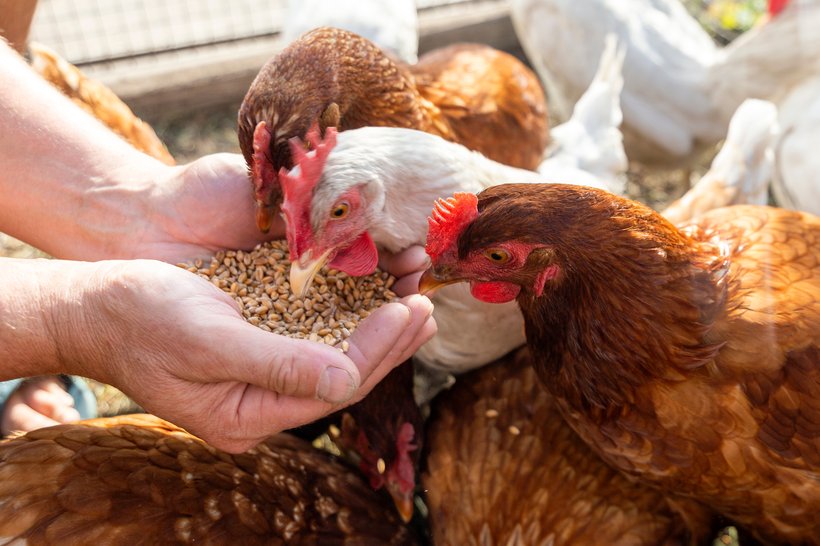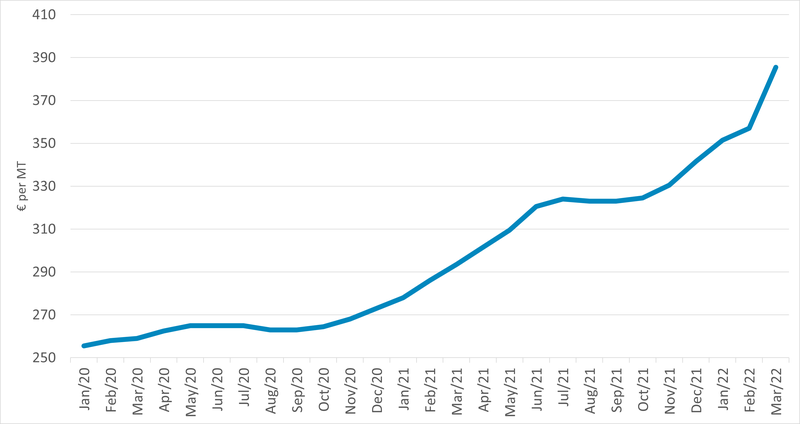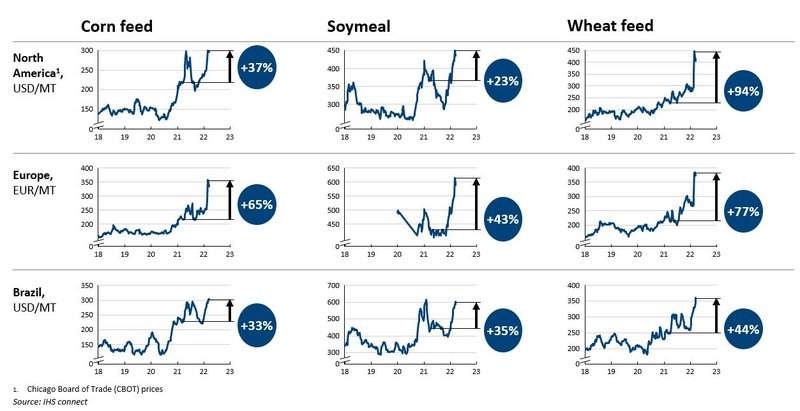
Published on April 14, 2022
Feed prices on the rise, can alternative feed materials be used for chicken diets?
It is well known that cost of feed is the major cost of egg production. Feed prices have been on the rise for more than 1 year, with a strong increase lately due to the uncertainty of the export of feed materials coming from Ukraine and Russia. Other reasons for the rising feed prices are disappointing harvests related to climate change (drought, fires, and severe flooding), a higher demand of raw materials because of the recovery of the global demand for animal protein (declined due to COVID-19), increasing animal protein consumption and an increasing demand of feed related to the recovering from African Swine fever.
The rising chicken feed prices, shown in Figures 1 and 2, have their direct impact on the composition of layer feed and are resulting in the increase in the use of alternative feed stuffs in laying hen nutrition. The most expensive nutrients in chicken diets are energy and protein, which are at the same time the major nutrients in a laying hen diet. The energy intake in a laying hen mainly depends on the hen’s maintenance cost, her activity and the energy needed to maintain the required body temperature. The average daily protein intake depends on the requirements to produce eggs and the hen’s maintenance. The total daily cost of feed is depending on the feed price (price paid per kg/feed) and the total kg of feed consumed by the flock. Depending on the market situation, it can be cheaper to steer to a higher feed intake with a lower feed price or vice versa. As laying hens mainly eat according to the energy level present in the feed provided to them, it is essential to track the flocks feed intake as accurate as you can and to formulate the protein levels according to the recorded feed intake.
Recent feed price development

Figure 1 Feed price of a layer 1 diet, Wageningen University & Research
According to the analysts of the Rabobank, feed prices are expected to keep on increasing till at least the second Quarter (Q2) of 2022 (do check table 1). This table shows the price increase for some of the major raw materials that are used in chicken feed compared to the quarter before. Both actual prices (or historical prices) and forecasted prices (f) are shown. It clearly becomes visible that no price decreases are expected before the new harvests coming in.
.
| Q3 2021 | Q4 2021 | Q1 2022 | Q2 2022 (f) | Q3 2022 (f) | Q4 2022 (f) | Q1 2023 (f) | |
|---|---|---|---|---|---|---|---|
| Wheat (CBOT) | 103% | 112% | 114% | 133% | 95% | 98% | 95% |
| Wheat (Matif) | 107% | 121% | 107% | 128% | 92% | 97% | 94% |
| Corn | 85% | 101% | 117% | 121% | 99% | 98% | 97% |
| Soybeans | 91% | 92% | 123% | 117% | 98% | 98% | 96% |
| Soy oil | 98% | 94% | 116% | 110% | 98% | 98% | 98% |
| Soybean meal | 88% | 101% | 126% | 112% | 97% | 97% | 96% |
| Palm oil | 109% | 113% | 118% | 100% | 96% | 98% | 100%[EL1] |

Figure 2, the evolution of feed commodities costs, IHS connect
Using alternative feed materials and a higher inclusion of by-products will likely reduce the feed costs. Examples of commonly used alternative protein sources to replace soybean meal are sunflower meal, rapeseed meal, cotton seed meal, groundnut meal, distiller dried grains with soluble (DDGS) and meat and bone meal. Next to being a valuable source of protein, meat and bone meal also contribute in calcium and phosphorus. Prices of high protein sunflower have gone sky-high as especially Ukraine and Russia are known for its intensive production of high protein sunflower (together they account for 80% of global sunflower oil exports), and therefore not a realistic option to reduce the cost of chicken feed. Alternative energy sources can include bakery by-products. Please note that when using alternative ingredients in formulating poultry diets, it is key to formulate based on the digestible amino acid levels. Most protein sources have a different amino acid pattern compared to that of soybean meal, formulating on digestible amino acid levels will help to maintain both the correct amino acid balance and level.
Most alternative ingredients have lower digestibility and utilization rates compared to soybean meal (shown in Table 2). Part of this lower digestibility and utilization rate is caused by a higher level of antinutritional factors in these alternative protein sources, like gossypol, glucosinolates and trypsin inhibitors. Another important factor is the quality of the raw materials itself. Most by-products are residues that stay behind during the production process of oils, ethanol, etc. As a result, the nutrient composition and protein quality of the product may vary greatly between processing plants and even between production shifts.
.
| Raw material | Protein digestibility laying hens |
|---|---|
| Soybean meal | 86% |
| Sunflower meal | 85% |
| Rapeseed meal | 76% |
| Cottonseed meal | 65% |
| Groundnut meal | 85% |
| DDGS | 71% |
| Meat and bone meal | 73% |
Proper protein digestibility results in better feed efficiency and therefore has its positive impact on the sustainability of egg production. Furthermore, a higher protein digestibility results in less protein leftovers towards the end of the intestines and therefore a reduced risk on intestinal health. Protein digestibility depends heavily on feed processing, like heat treatment, the grinding quality, the type of raw materials, other ingredients like enzymes, and very important overall intestinal health. It is essential to introduce alternative protein sources already during the rearing period to the chicken diet, and slowly introduce new ingredients. When adding a new feed ingredient to the poultry diet, take a close look to the impact on feed consumption and the production results, careful monitoring of this data will help you to better understand what the impact is of the changes to the diet. Analysing the results will help to prevent an overestimation of the digestibility of your new feed composition.
In poultry breeding, it is key to already breed and select the pure line breeding stock on diets that are containing alternative feed materials, this will help to breed for commercial chicken breeds that can utilize these alternative feed materials. All the laying hen breeds of Hendrix Genetics have been selected on diets with high levels of antinutritional factors and lower digestibility rates. Therefore, all the Hendrix Genetics Breeds can cope with well formulated chicken diets containing raw alternative sources of raw materials. As it is expected that feed prices will remain high in the coming years, we are confident that our chicken genetics will be able to contribute towards a sustainable future of egg production.
